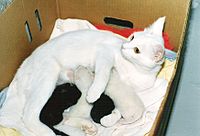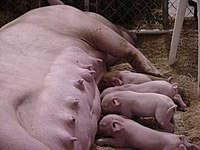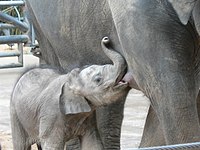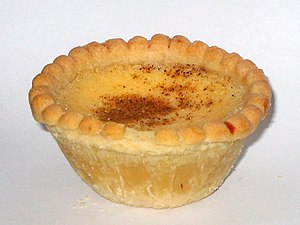Contents
[hide]Humans[edit]
Main article: Breast
Histology[edit]
A mammary gland is a specific type of apocrine gland specialized for manufacture of colostrum when giving birth. Mammary glands can be identified as apocrine because they exhibit striking "decapitation" secretion. Many sources assert that mammary glands are modified sweat glands.[4][5][6] Some authors dispute that and argue instead that they are sebaceous glands.[4]Structure[edit]
The basic components of a mature mammary gland are the alveoli (hollow cavities, a few millimeters large) lined with milk-secreting cuboidal cells and surrounded by myoepithelial cells. These alveoli join to form groups known as lobules. Each lobule has a lactiferous duct that drains into openings in the nipple. The myoepithelial cells contract under the stimulation of oxytocin, excreting the milk secreted by alveolar units into the lobule lumen toward the nipple. As the infant begins to suck, the oxytocin-mediated "let down reflex" ensues and the mother's milk is secreted – not sucked from the gland – into the baby's mouth.All the milk-secreting tissue leading to a single lactiferous duct is called a "simple mammary gland"; in a "complex mammary gland" all the simple mammary glands serve one nipple. Humans normally have two complex mammary glands, one in each breast, and each complex mammary gland consists of 10–20 simple glands. The presence of more than two nipples is known as polythelia and the presence of more than two complex mammary glands as polymastia.
Maintaining the correct polarized morphology of the lactiferous duct tree requires another essential component – mammary epithelial cells extracellular matrix (ECM) which, together with adipocytes, fibroblast, inflammatory cells, and others, constitute mammary stroma. [7] Mammary epithelial ECM mainly contains myoepithelial basement membrane and the connective tissue. They not only help to support mammary basic structure, but also serve as a communicating bridge between mammary epithelia and their local and global environment throughout this organ's development.[8][9]
Development and hormonal control[edit]
Further information: Mammary gland development
Mammary glands develop during different growth cycles. They exist in both sexes during embryonic stage, forming only a rudimentary duct tree at birth. In this stage, mammary gland development depends on systemic (and maternal) hormones,[7] but is also under the (local) regulation of paracrine communication between neighboring epithelial and mesenchymal cells by parathyroid hormone-related protein(PTHrP).[10] This locally secreted factor gives rise to a series of outside-in and inside-out positive feedback between these two types of cells, so that mammary bud epithelial cells can proliferate and sprout down into the mesenchymal layer until they reach the fat pad to begin the first round of branching.[7] At the same time, the embryonic mesenchymal cells around the epithelial bud receive secreting factors activated by PTHrP, such as BMP4. These mesenchymal cells can transform into a dense, mammary-specific mesenchyme, which later develop into connective tissue with fibrous threads, forming blood vessels and the lymph system.[11] A basement membrane, mainly containing laminin and collagen, formed afterward by differentiated myoepithelial cells, keeps the polarity of this primary duct tree.Lactiferous duct development occurs in females in response to circulating hormones. First development is frequently seen during pre- and postnatal stages, and later during puberty. Estrogen promotes branching differentiation,[12] whereas in males testosterone inhibits it. A mature duct tree reaching the limit of the fat pad of the mammary gland comes into being by bifurcation of duct terminal end buds (TEB), secondary branches sprouting from primary ducts[8][13] and proper duct lumen formation. These processes are tightly modulated by components of mammary epithelial ECM interacting with systemic hormones and local secreting factors. However, for each mechanism the epithelial cells' "niche" can be delicately unique with different membrane receptor profiles and basement membrane thickness from specific branching area to area, so as to regulate cell growth or differentiation sub-locally.[14] Important players include beta-1 integrin, epidermal growth factor receptor (EGFR), laminin-1/5, collagen-IV, matrix metalloproteinase(MMPs), heparan sulfate proteoglycans, and others. Elevated circulating level of growth hormone and estrogen get to multipotent cap cells on TEB tips through a thin, leaky layer of basement membrane. These hormones promote specific gene expression. Hence cap cells can differentiate into myoepithelial and luminal (duct) epithelial cells, and the increased amount of activated MMPs can degrade surrounding ECM helping duct buds to reach further in the fat pads.[15][16] On the other hand, basement membrane along the mature mammary ducts is thicker, with strong adhesion to epithelial cells via binding to integrin and non-integrin receptors. When side branches develop, it is a much more “pushing-forward” working process including extending through myoepithelial cells, degrading basement membrane and then invading into a periductal layer of fibrous stromal tissue.[8] Degraded basement membrane fragments (laminin-5) roles to lead the way of mammary epithelial cells migration.[17] Whereas, laminin-1 interacts with non-integrin receptor dystroglycan negatively regulates this side branching process in case of cancer.[18] These complex "Yin-yang" balancing crosstalks between mammary ECM and epithelial cells "instruct" healthy mammary gland development until adult.
Secretory alveoli develop mainly in pregnancy, when rising levels of prolactin, estrogen, and progesterone cause further branching, together with an increase in adipose tissue and a richer blood flow. In gestation, serum progesterone remains at a stably high concentration so signaling through its receptor is continuously activated. As one of the transcribed genes, Wnts secreted from mammary epithelial cells act paracrinely to induce more neighboring cells' branching.[19][20] When the lactiferous duct tree is almost ready, "leaves" alveoli are differentiated from luminal epithelial cells and added at the end of each branch. In late pregnancy and for the first few days after giving birth, colostrum is secreted. Milk secretion (lactation) begins a few days later due to reduction in circulating progesterone and the presence of another important hormone prolactin, which mediates further alveologenesis, milk protein production, and regulates osmotic balance and tight junction function. Laminin and collagen in myoepithelial basement membrane interacting with beta-1 integrin on epithelial surface again, is essential in this process.[21][22] Their binding ensures correct placement of prolactin receptors on the basal lateral side of alveoli cells and directional secretion of milk into lactiferous ducts.[21][22] Suckling of the baby causes release of the hormone oxytocin, which stimulates contraction of the myoepithelial cells. In this combined control from ECM and systemic hormones, milk secretion can be reciprocally amplified so as to provide enough nutrition for the baby.
During weaning, decreased prolactin, missing mechanical stimulation (baby suckling), and changes in osmotic balance caused by milk stasis and leaking of tight junctions cause cessation of milk production. In some species there is complete or partial involution of alveolar structures after weaning, in humans there is only partial involution and the level of involution in humans appears to be highly individual. In some other species (such as cows), all alveoli and secretory duct structures collapse by programmed cell death (apoptosis) and autophagy for lack of growth promoting factors either from the ECM or circulating hormones.[23][24] At the same time, apoptosis of blood capillary endothelial cells speeds up the regression of lactation ductal beds. Shrinkage of the mammary duct tree and ECM remodeling by various proteinase is under the control of somatostatin and other growth inhibiting hormones and local factors.[25] This major structural change leads loose fat tissue to fill the empty space afterward. But a functional lactiferous duct tree can be formed again when a female is pregnant again.
Breast cancer[edit]
Tumorigenesis in mammary glands can be induced biochemically by abnormal expression level of circulating hormones or local ECM components,[26] or from a mechanical change in the tension of mammary stroma.[27] Under either of the two circumstances, mammary epithelial cells would grow out of control and eventually result in cancer. Almost all instances of breast cancer originate in the lobules or ducts of the mammary glands.Other mammals[edit]
The constantly protruding breasts of the adult human female, unusually large relative to body size, are a unique evolutionary development whose purpose is not yet fully known (see breasts); other mammals tend to have less conspicuous mammary glands that protrude only while actually filling with milk. The number and positioning of complex and simple mammary glands varies widely in different mammals. The nipples and glands can occur anywhere along the two milk lines, two nearly parallel lines along the ventral aspect of the body. In general most mammals develop mammary glands in pairs along these lines, with a number approximating the number of young typically birthed at a time. The number of nipples varies from 2 (in most primates) to 18 (in pigs). The Virginia Opossum has 13, one of the few mammals with an odd number.[28][29] The following table lists the number and position of glands normally found in a range of mammals:| Species[30] | Anterior (thoracic) | Intermediate (abdominal) | Posterior (inguinal) | Total |
|---|---|---|---|---|
| Goat, sheep, horse guinea pig | 0 | 0 | 2 | 2 |
| Cattle | 0 | 0 | 4 | 4 |
| Cat | 2 | 2 | 4 | 8 |
| Dog[31] | 4 | 2 | 2 or 4 | 8 or 10 |
| Mouse | 6 | 0 | 4 | 10 |
| Rat | 6 | 2 | 4 | 12 |
| Pig | 6 | 6 | 6 | 18 |
| proboscideans, primates | 2 | 0 | 0 | 2 |
Mammary glands are true protein factories, and several labs have constructed transgenic animals, mainly goats and cows, to produce proteins for pharmaceutical use.[34] Complex glycoproteins such as monoclonal antibodies or antithrombin cannot be produced by genetically engineered bacteria, and the production in live mammals is much cheaper than the use of mammalian cell cultures.
Evolution[edit]
The evolution of the mammary gland is difficult to explain; this is because mammary glands are typically required by mammals to feed their young. There are many theories on how mammary glands evolved, for example, it is believed that the mammary gland is a transformed sweat gland, more closely related to apocrine sweat glands.[35] Since mammary glands do not fossilize well, supporting such theories with fossil evidence is difficult. Many of the current theories are based on comparisons between lines of living mammals – monotremes, marsupials and eutherians. One theory proposes that mammary glands evolved from glands that were used to keep the eggs of early mammals moist[36][37] and free from infection[38][39] (monotremes still lay eggs). Other theories suggest that early secretions were used directly by hatched young,[40] or that the secretions were used by young to help them orient to their mothers.[41]Lactation is assumed to have developed long before the evolution of the mammary gland and mammals; see evolution of lactation.
Gallery[edit]
See also[edit]
PARTNERSHIP AGREEMENT
of the
Yummy Investment Club
This AGREEMENT of PARTNERSHIP is made as of
October 22, 2013 ,
by and between the undersigned Partners.
I. Formation
The undersigned hereby form a General
Partnership in, and in accordance with the laws of, the Most tasteful of All
the kingdoms.
II. Name
The name of the Partnership shall be Tasteful
Restraint .
III. Term
The Partnership shall begin on October
22, 2013 and shall continue until September
6, 2069 of the same year and thereafter from year to year unless
earlier terminated as hereinafter provided.
IV. Purpose
No touchy.
V. Meetings
Periodic meetings shall be held regularly as
determined by the Partnership.
VI. Capital Contributions
The Partners will each make minimum monthly
investments of $69 at regular monthly meetings. Partners may also make optional
additional contributions in any $69 increment(s). Regular monthly contributions,
normally collected at meetings, are due prior to the scheduled meeting in the
case of any planned absence, or by the end of the third day after the meeting
from anyone who was unable to attend that monthly meeting due to an emergency
or illness. No Partner's capital account shall exceed twenty percent (20%) of
the capital accounts of all Partners.
VII. Valuation of the Partnership
Big Touching Yummy NO!
VIII. Capital Accounts
Pay lots of 69
IX. Management
Will is in big charge and Jack is the
director of yummy
X. Sharing of Profits and Losses
The money will always be 69. All the other
money is donated to the fixing of Jim
XI. Book of Account
Write of any inappropriate yummy touching
XII. Annual Accounting and Partnership Audit Committee
Every year, on the 6th day of
the 9th month, there will be one big yummy touch.
XIII. Bank Account
The Bank Number is 6969696969696969
XIV. Broker Account
Jack is the breaker
§ All securities shall be purchased in the name of the Partnership.
§ All securities shall be kept in the Partnership safe deposit box or
with the broker.
§ The Presiding Partner and the Assistant Presiding Partner shall be
the custodians of all securities.
§ Any corporation or transfer agent called upon to transfer any
securities to or from the name of the Partnership shall be entitled to rely on
instructions or assignments signed by any Partner without inquiry as to the
authority of the person(s) signing such instructions or assignments, and
without inquiry as to the validity of any transfer to or from the name of the Partnership.
§ At the time of a transfer of securities, the corporation or transfer
agent is entitled to assume (1) that the Partnership is still in existence and
(2) that this Agreement is in full force and effect and has not been amended
unless the corporation or transfer agent has received written notice to the
contrary.
XV. No Compensation
If big yum happens no money will be given
to fix it, we will still fix Jim
XVI. Additional Partners
Additional Partners may be admitted at any
time, upon the unanimous consent of the Partners, so long as the number of Partners
does not exceed 69.
XVII. Transfers to a Trust
We trust fixing Jim and so we always fix
him
XVIII. Removal of a Partner
If naughty happens then big fixing happens
XIX. Termination of Partnership
Big bang is bad
XX. Voluntary Withdrawal (Partial or Full) of a Partner
You are trapped forever
XXI. Death or Incapacity of a Partner
If you die you give all money to Fix Jim
foundation
XXII. Terms of Payment
Pay Jack
XXIII. Forbidden Acts
No Partner shall:
Rape
|
Partner (Printed Name)
|
Partner (Signature)
|
Date Signed
|
|
|
|
|
|
|
|
|
|
|
|
|
|
|
|
|
|
|
|
|
|
|
|
|
|
|
|
|
|
|
|
|
|
|
|
|
|
|
|
|
|
|
|
|
|
|
|
|










